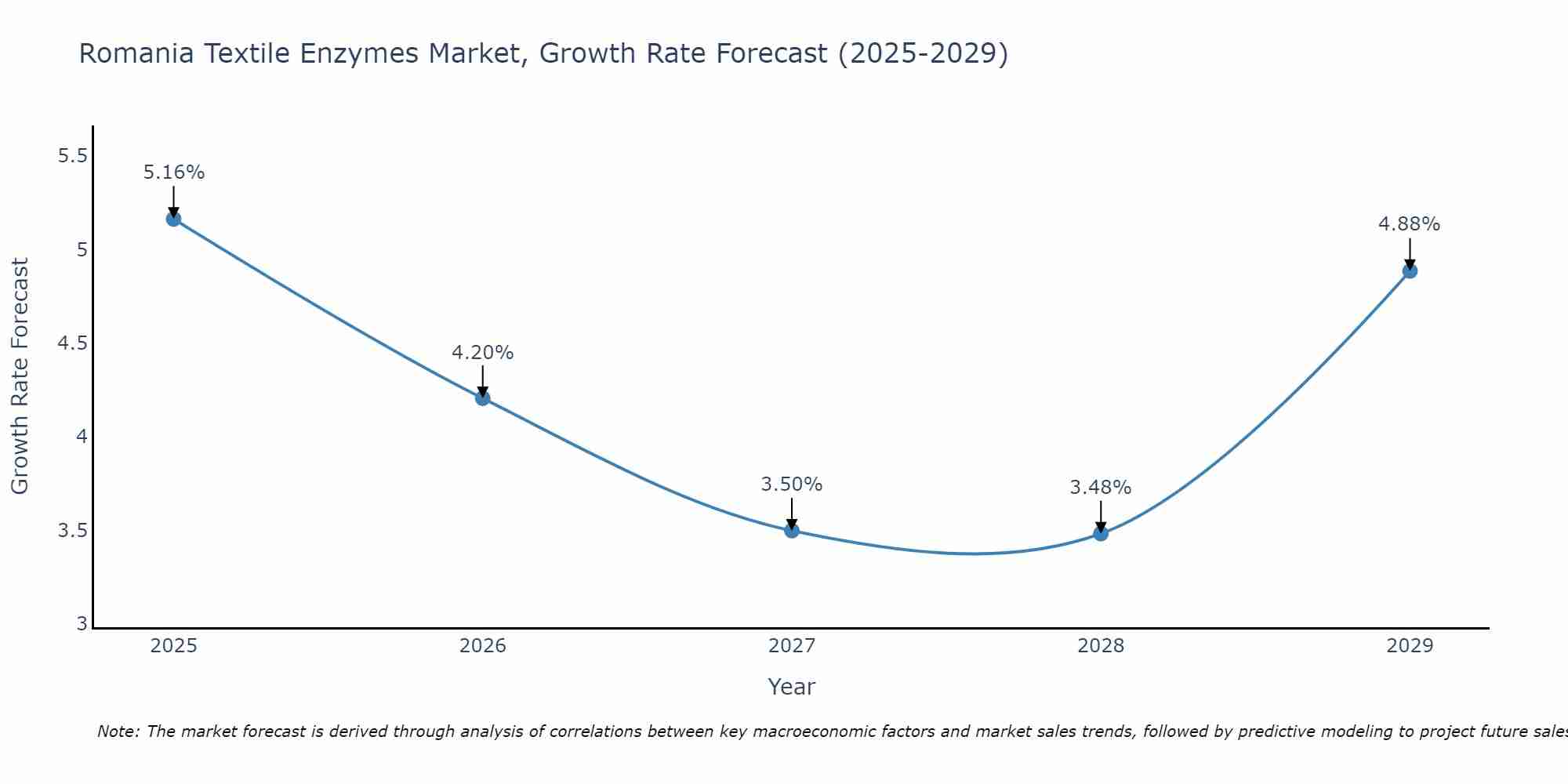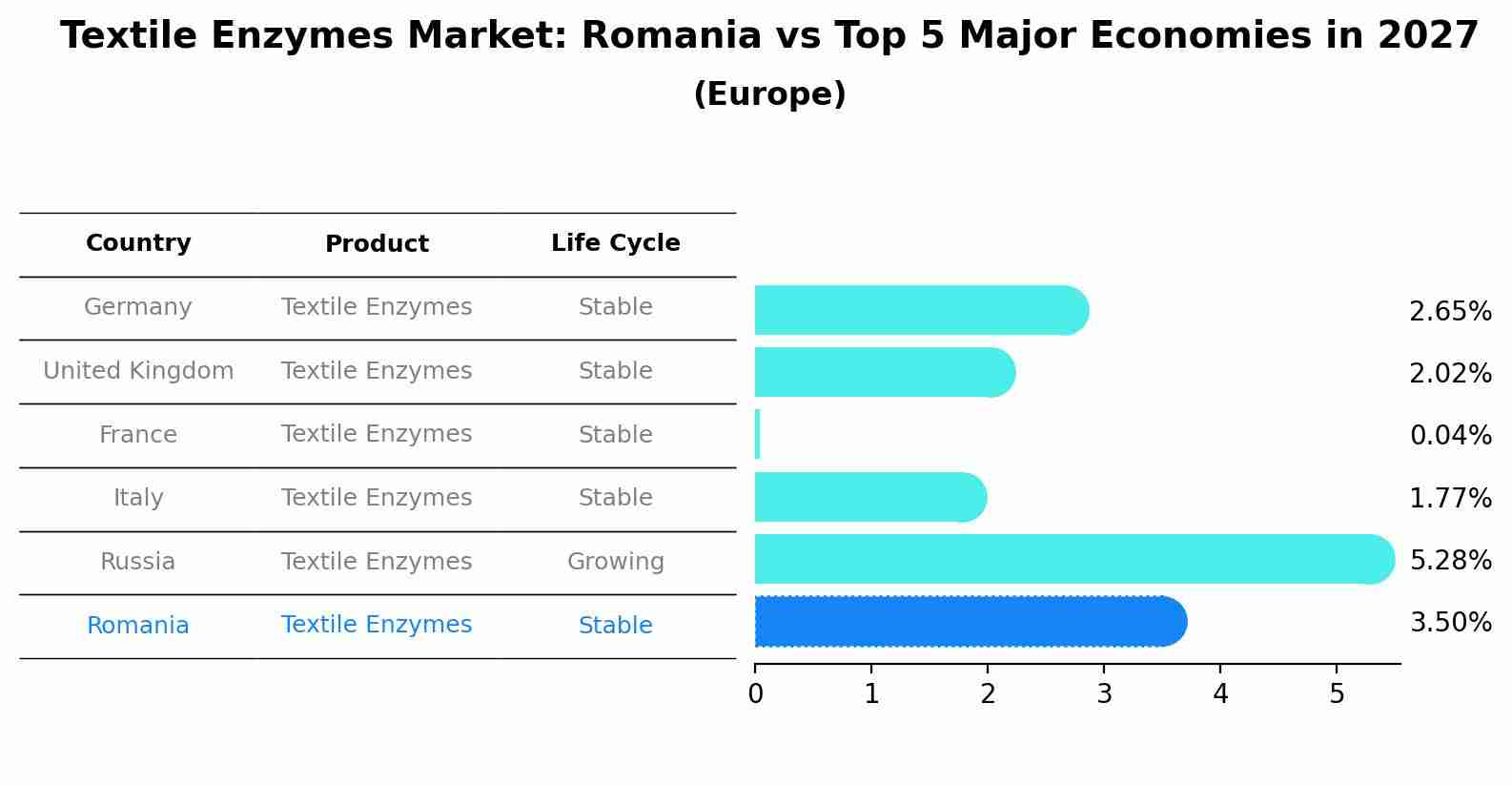Romania Textile Enzymes Market Outlook | Value, Analysis, Forecast, Share, Companies, Growth, Revenue, Size, Trends, Industry & COVID-19 IMPACT
| Product Code: ETC094057 | Publication Date: Jun 2021 | Updated Date: Jun 2025 | Product Type: Report | |
| Publisher: 6Wresearch | Author: Ravi Bhandari | No. of Pages: 70 | No. of Figures: 35 | No. of Tables: 5 |
Romania Textile Enzymes Market Size Growth Rate
The Romania Textile Enzymes Market is projected to witness mixed growth rate patterns during 2025 to 2029. Although the growth rate starts strong at 5.16% in 2025, it steadily loses momentum, ending at 4.88% by 2029.

Textile Enzymes Market: Romania vs Top 5 Major Economies in 2027 (Europe)
By 2027, the Textile Enzymes market in Romania is anticipated to reach a growth rate of 3.50%, as part of an increasingly competitive Europe region, where Germany remains at the forefront, supported by United Kingdom, France, Italy and Russia, driving innovations and market adoption across sectors.

Romania Textile Enzymes Market Overview
The Romania Textile Enzymes Market is experiencing steady growth due to increasing demand for eco-friendly and sustainable textile production processes. Enzymes are being widely adopted in the textile industry for various applications such as desizing, bio-polishing, and denim abrasion. The market is driven by factors like the rising awareness about the environmental impact of traditional textile processing methods, as well as the growing focus on product quality and performance. Key players in the Romania Textile Enzymes Market include Novozymes A/S, BASF SE, and Dupont, among others. The market is expected to further expand as textile manufacturers seek innovative solutions to improve efficiency and reduce costs while meeting the demands for more environmentally friendly production practices.
Romania Textile Enzymes Market Trends
The Romania Textile Enzymes Market is experiencing several key trends. One major trend is the increasing demand for eco-friendly and sustainable textile processing solutions, driving the adoption of enzyme-based technologies in the industry. Enzymes are being utilized to reduce water and energy consumption, minimize chemical usage, and improve overall production efficiency. Another trend is the rising focus on innovation and product development to cater to the evolving consumer preferences for high-performance and multifunctional textiles. Additionally, the market is witnessing a growing emphasis on cost-effective and environmentally friendly solutions to meet stringent regulations and sustainability goals. Overall, the Romania Textile Enzymes Market is poised for growth as manufacturers and consumers alike prioritize sustainability and innovation in textile processing.
Romania Textile Enzymes Market Challenges
In the Romania Textile Enzymes Market, some challenges include the high competition among local and international players, leading to pricing pressures and the need for continuous product innovation to stay competitive. Additionally, there is a growing concern for environmental sustainability, driving the demand for eco-friendly and biodegradable enzymes in textile processing. Regulatory complexities and evolving compliance standards also pose challenges for market players in ensuring product safety and meeting industry regulations. Furthermore, fluctuations in raw material prices and the need for efficient supply chain management add another layer of complexity to the market dynamics, requiring companies to adapt quickly to changing market conditions and consumer preferences to maintain a strong foothold in the Romania Textile Enzymes Market.
Romania Textile Enzymes Market Investment Opportunities
The Romania Textile Enzymes Market presents promising investment opportunities due to the growing demand for eco-friendly and sustainable textile production processes. Enzymes are increasingly being used in the textile industry to reduce water and energy consumption, improve fabric quality, and enhance the efficiency of dyeing and finishing processes. Investing in companies that specialize in developing and manufacturing textile enzymes can be lucrative as the market continues to expand. Additionally, the increasing focus on environmental regulations and consumer awareness towards sustainable fashion further drive the adoption of textile enzymes in Romania. Potential investors can explore opportunities in partnering with local textile manufacturers, investing in research and development of innovative enzyme technologies, or entering into distribution agreements with established enzyme suppliers in the region.
Romania Textile Enzymes Market Government Policy
In Romania, government policies related to the Textile Enzymes Market primarily focus on environmental sustainability and industry regulation. The government has implemented strict guidelines for the use of enzymes in textile production to ensure that they are safe for both consumers and the environment. Additionally, there are initiatives in place to promote research and development in the field of textile enzymes, aiming to increase the competitiveness of the Romanian textile industry on a global scale. The government also supports measures to reduce the environmental impact of textile production, encouraging the adoption of eco-friendly enzymes and processes. Overall, the regulatory framework in Romania emphasizes the importance of sustainable practices and innovation in the textile enzymes market.
Romania Textile Enzymes Market Future Outlook
The Romania Textile Enzymes Market is poised for steady growth in the coming years, driven by increasing demand for sustainable and eco-friendly textile processing solutions. Enzymes offer numerous benefits such as reduced water and energy consumption, shorter processing times, and improved product quality, making them increasingly popular among textile manufacturers in Romania. Additionally, the growing emphasis on environmental regulations and consumer preferences for green products are expected to further boost the adoption of textile enzymes in the market. Key players are focusing on product innovation and strategic partnerships to expand their market presence and cater to the evolving needs of the textile industry in Romania. Overall, the Romania Textile Enzymes Market is projected to experience consistent growth as the industry continues to prioritize sustainability and efficiency in textile processing.
Key Highlights of the Report:
- Romania Textile Enzymes Market Outlook
- Market Size of Romania Textile Enzymes Market, 2021
- Forecast of Romania Textile Enzymes Market, 2027
- Historical Data and Forecast of Romania Textile Enzymes Revenues & Volume for the Period 2018 - 2027
- Romania Textile Enzymes Market Trend Evolution
- Romania Textile Enzymes Market Drivers and Challenges
- Romania Textile Enzymes Price Trends
- Romania Textile Enzymes Porter's Five Forces
- Romania Textile Enzymes Industry Life Cycle
- Historical Data and Forecast of Romania Textile Enzymes Market Revenues & Volume By Type for the Period 2018 - 2027
- Historical Data and Forecast of Romania Textile Enzymes Market Revenues & Volume By Cellulase for the Period 2018 - 2027
- Historical Data and Forecast of Romania Textile Enzymes Market Revenues & Volume By Amylase for the Period 2018 - 2027
- Historical Data and Forecast of Romania Textile Enzymes Market Revenues & Volume By Catalase for the Period 2018 - 2027
- Historical Data and Forecast of Romania Textile Enzymes Market Revenues & Volume By Pectinase for the Period 2018 - 2027
- Historical Data and Forecast of Romania Textile Enzymes Market Revenues & Volume By Laccase for the Period 2018 - 2027
- Historical Data and Forecast of Romania Textile Enzymes Market Revenues & Volume By Others for the Period 2018 - 2027
- Historical Data and Forecast of Romania Textile Enzymes Market Revenues & Volume By Application for the Period 2018 - 2027
- Historical Data and Forecast of Romania Textile Enzymes Market Revenues & Volume By Bio-polishing for the Period 2018 - 2027
- Historical Data and Forecast of Romania Textile Enzymes Market Revenues & Volume By Desizing for the Period 2018 - 2027
- Historical Data and Forecast of Romania Textile Enzymes Market Revenues & Volume By Enzymatic Bleaching for the Period 2018 - 2027
- Historical Data and Forecast of Romania Textile Enzymes Market Revenues & Volume By Bioscouring for the Period 2018 - 2027
- Historical Data and Forecast of Romania Textile Enzymes Market Revenues & Volume By Others for the Period 2018 - 2027
- Romania Textile Enzymes Import Export Trade Statistics
- Market Opportunity Assessment By Type
- Market Opportunity Assessment By Application
- Romania Textile Enzymes Top Companies Market Share
- Romania Textile Enzymes Competitive Benchmarking By Technical and Operational Parameters
- Romania Textile Enzymes Company Profiles
- Romania Textile Enzymes Key Strategic Recommendations
Frequently Asked Questions About the Market Study (FAQs):
- Single User License$ 1,995
- Department License$ 2,400
- Site License$ 3,120
- Global License$ 3,795
Search
Thought Leadership and Analyst Meet
Our Clients
Related Reports
- Afghanistan Apparel Market (2026-2032) | Growth, Outlook, Industry, Segmentation, Forecast, Size, Companies, Trends, Value, Share, Analysis & Revenue
- Canada Oil and Gas Market (2026-2032) | Share, Segmentation, Value, Industry, Trends, Forecast, Analysis, Size & Revenue, Growth, Competitive Landscape, Outlook, Companies
- Germany Breakfast Food Market (2026-2032) | Industry, Share, Growth, Size, Companies, Value, Analysis, Revenue, Trends, Forecast & Outlook
- Australia Briquette Market (2025-2031) | Growth, Size, Revenue, Forecast, Analysis, Trends, Value, Share, Industry & Companies
- Vietnam System Integrator Market (2025-2031) | Size, Companies, Analysis, Industry, Value, Forecast, Growth, Trends, Revenue & Share
- ASEAN and Thailand Brain Health Supplements Market (2025-2031) | Strategy, Consumer Insights, Analysis, Investment Trends, Opportunities, Growth, Size, Share, Industry, Revenue, Segments, Value, Segmentation, Supply, Forecast, Restraints, Outlook, Competition, Drivers, Trends, Demand, Pricing Analysis, Competitive, Strategic Insights, Companies, Challenges
- ASEAN Bearings Market (2025-2031) | Strategy, Consumer Insights, Analysis, Investment Trends, Opportunities, Growth, Size, Share, Industry, Revenue, Segments, Value, Segmentation, Supply, Forecast, Restraints, Outlook, Competition, Drivers, Trends, Demand, Pricing Analysis, Competitive, Strategic Insights, Companies, Challenges
- Europe Flooring Market (2025-2031) | Outlook, Share, Industry, Trends, Forecast, Companies, Revenue, Size, Analysis, Growth & Value
- Saudi Arabia Manlift Market (2025-2031) | Outlook, Size, Growth, Trends, Companies, Industry, Revenue, Value, Share, Forecast & Analysis
- Uganda Excavator, Crane, and Wheel Loaders Market (2025-2031) | Strategy, Consumer Insights, Analysis, Investment Trends, Opportunities, Growth, Size, Share, Industry, Revenue, Segments, Value, Segmentation, Supply, Forecast, Restraints, Outlook, Competition, Drivers, Trends, Demand, Pricing Analysis, Competitive, Strategic Insights, Companies, Challenges
Industry Events and Analyst Meet
Whitepaper
- Middle East & Africa Commercial Security Market Click here to view more.
- Middle East & Africa Fire Safety Systems & Equipment Market Click here to view more.
- GCC Drone Market Click here to view more.
- Middle East Lighting Fixture Market Click here to view more.
- GCC Physical & Perimeter Security Market Click here to view more.
6WResearch In News
- Doha a strategic location for EV manufacturing hub: IPA Qatar
- Demand for luxury TVs surging in the GCC, says Samsung
- Empowering Growth: The Thriving Journey of Bangladesh’s Cable Industry
- Demand for luxury TVs surging in the GCC, says Samsung
- Video call with a traditional healer? Once unthinkable, it’s now common in South Africa
- Intelligent Buildings To Smooth GCC’s Path To Net Zero


















